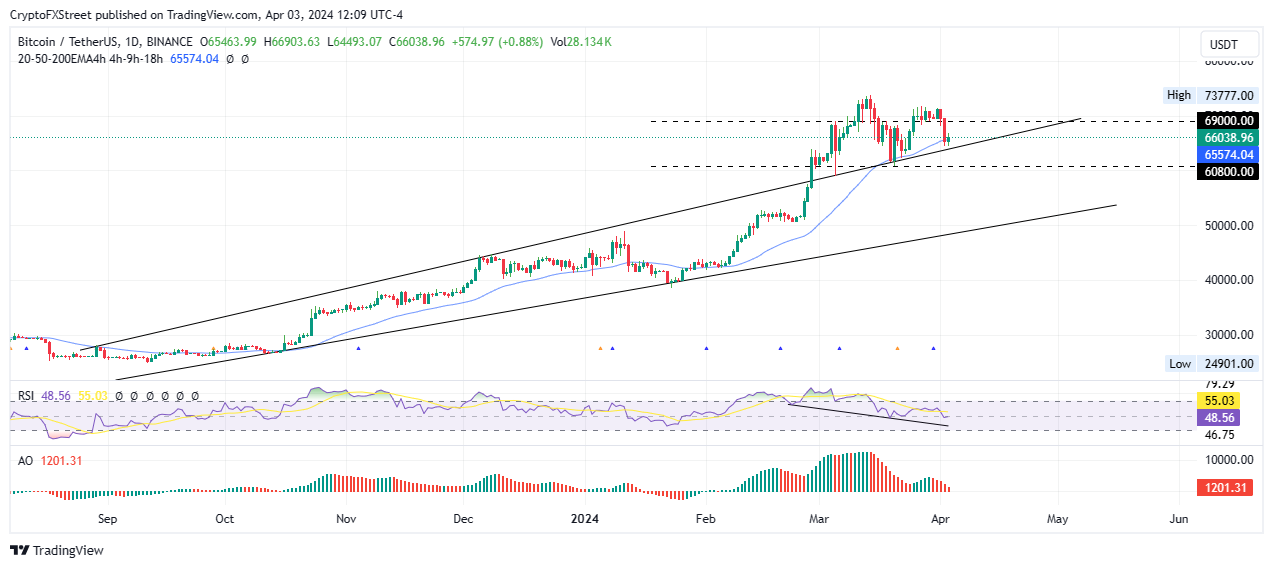- Bitcoin price is testing the 200-day EMA for a second time this week.
- A breakout above $69,000 and holding there with stable price action can lead to a long.
- A retest of $68,000 followed by a healthy rejection can lead to a short toward $60,800.
Bitcoin (BTC) price is devoid of upward momentum, tethered to and testing a critical support as BTC bulls fail to show up on Wednesday. It comes amid anticipation for the halving event, estimated to be just over a week out.
Also Read: Markets may not see a new Bitcoin price ATH pre-halving unless $69K breaks
Bitcoin tests 200-day EMA
Bitcoin price has slipped below the support offered by a critical support level, the 200-day Exponential Moving Average (EMA) at $65,574. However, the breakdown is not decisive as the pioneer cryptocurrency continues to hold above one of two trendlines that have been pivotal in BTC action for over six months.
Analysts are watching this level with concern that if it gives in, it could lead to more losses. This was seen during the second half of January, giving way to as much as 10% in downside momentum. The expectation is that if it holds, it could precipitate a rebound.
The 200EMA on the #Bitcoin four-hour chart has been formidable support. Since early February, it has prevented #BTC from dropping further.
For this reason, I’m paying close attention to this level because if it holds, it guarantees a rebound, but if it breaks as it did in… pic.twitter.com/cnfruT9wUJ
— Ali (@ali_charts) April 2, 2024
With inflows from BTC ETFs back above water, the assumption is that the downside potential seen in the Bitcoin price is attributed to smart money looking to catch retail off guard. Other theories suggest that the dump in the BTC market comes as cat-themed tokens are peaking.
Meanwhile, Federal Reserve chair Jerome Powell has urged markets not to expect interest rate cuts until there is more confidence on inflation.
FED’S JEROME POWELL: DON’T THINK INFLATION IS REVERSING HIGHER, WOULD BE QUITE DISRUPTIVE
— Evan (@StockMKTNewz) April 3, 2024
Powell also noted that reducing rates too soon could result in a reversal of the progress seen on inflation so far:
Given the strength of the economy and progress on inflation so far, we have time to let the incoming data guide our decisions on policy. If the economy evolves broadly as we expect, most FOMC participants see it as likely to be appropriate to begin lowering the policy rate at some point this year.
In the immediate aftermath, Bitcoin price surged by 1% on concerns about inflation and, therefore, currency devaluation.
Bitcoin price prediction as 200-EMA remains critical
Bitcoin price action continues to maintain higher lows, while the Relative Strength Index (RSI) is showing lower lows. This is a typical hidden divergence, which could see BTC price drop before its potential leg up.
The position of the RSI below 50 is concerning, accentuated by the dwindling volumes of the Awesome Oscillator (AO). If Bitcoin price downtrend continues, a decisive slip below the 200-EMA, confirmed by BTC price moving below the upper trendline, would encourage more sell orders.
The ensuing selling pressure could see Bitcoin price test the $60,800 support, below which $60,000 would be imminent.

BTC/USDT 1-day chart
On the other hand, if the 200-EMA holds, it could provide the jumping-off point for Bitcoin price, sending it above the $69,000 threshold. If BTC bulls are able to hold above this level, it could initiate a continuation of the uptrend for BTC to reclaim the $73,777 peak before setting a new all-time high.
Bitcoin, altcoins, stablecoins FAQs
Bitcoin is the largest cryptocurrency by market capitalization, a virtual currency designed to serve as money. This form of payment cannot be controlled by any one person, group, or entity, which eliminates the need for third-party participation during financial transactions.
Altcoins are any cryptocurrency apart from Bitcoin, but some also regard Ethereum as a non-altcoin because it is from these two cryptocurrencies that forking happens. If this is true, then Litecoin is the first altcoin, forked from the Bitcoin protocol and, therefore, an “improved” version of it.
Stablecoins are cryptocurrencies designed to have a stable price, with their value backed by a reserve of the asset it represents. To achieve this, the value of any one stablecoin is pegged to a commodity or financial instrument, such as the US Dollar (USD), with its supply regulated by an algorithm or demand. The main goal of stablecoins is to provide an on/off-ramp for investors willing to trade and invest in cryptocurrencies. Stablecoins also allow investors to store value since cryptocurrencies, in general, are subject to volatility.
Bitcoin dominance is the ratio of Bitcoin’s market capitalization to the total market capitalization of all cryptocurrencies combined. It provides a clear picture of Bitcoin’s interest among investors. A high BTC dominance typically happens before and during a bull run, in which investors resort to investing in relatively stable and high market capitalization cryptocurrency like Bitcoin. A drop in BTC dominance usually means that investors are moving their capital and/or profits to altcoins in a quest for higher returns, which usually triggers an explosion of altcoin rallies.

























